
Mark J. Rebilas-USA TODAY Sports
Last week I covered the American League half of the flurry of transactional activity that occurred as a result of the 40-man roster and non-tender deadlines. Is any one move here as impactful as signing a Yoshinobu Yamamoto or a Matt Chapman? No, but when your favorite team experiences a rash of injuries in June, whether or not they have the depth to scrap and compete is often dictated by the people and processes that surround this day. Below are my thoughts on the National League, with some quick scouting snippets on most of the added players and thoughts about roster construction where I had something to say.
Arizona Diamondbacks
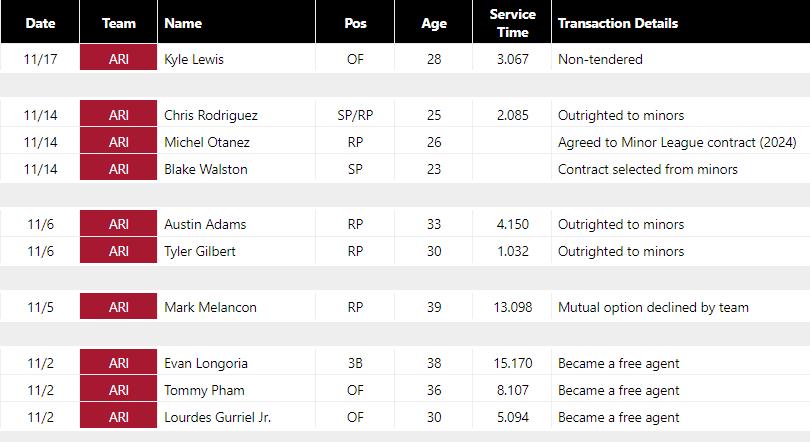
The Diamondbacks lone addition was lefty Blake Walston, a former $2.5 million high school signee who, despite being young for his class and physically projectable as an amateur, has seen his fastball velocity plateau and slightly decline since he signed. He’s had fits and starts where he’s thrown harder, but for the most part, Walston’s fastball still sits 89-92 mph and his performance peripherals took a nosedive in 2023, though part of that was likely because of the PCL hitting environment. The lanky 22-year-old is still a fair long-term prospect because of his age and what one could reasonably hope will still be late-arriving physicality, but for now, I’d consider him at the very back of Arizona’s 40-man starting pitching depth chart.
Arizona did a fine job upgrading the righty-hitting contingent of their position player group last offseason and at the trade deadline. Emmanuel Rivera was their best option of this sort in 2022 but became a defensive replacement in the wake of the Lourdes Gurriel Jr., Evan Longoria, and Tommy Pham additions. They’ll need to do this all over again because Longoria, Gurriel and Pham are all free agents, and the club non-tendered Kyle Lewis (another righty-hitting flier from the last year). It’s plausible that Jordan Lawlar’s arrival will facilitate a L/R Geraldo Perdomo/Rivera third base platoon, as well as some situations where Ketel Marte comes off the field for defensive purposes late in games. That might make this is a satisfactory mix for the D-backs if they can’t add a Jeimer Candelario or Matt Chapman everyday third base-type in free agency.
As has been the case for the last couple of years, the Diamondbacks have several redundant, smaller-framed, lefty-hitting outfielders stacked behind Corbin Carroll and Alek Thomas on their depth chart. Any of Jorge Barrosa (the best defender of this bunch, aside from Thomas), Jake McCarthy, Dominic Fletcher, or Pavin Smith could be moved in a trade driven by roster fit. McCarthy and Smith have one option left, the others have two. The free agent market is pretty flush with lefty-hitting outfielders who are about as good as this group or better, so while you can look around and see potential fits in places like Queens, Pittsburgh, Miami, or Washington, it feels like it’s a buyer’s market for this position group right now.
Atlanta Braves
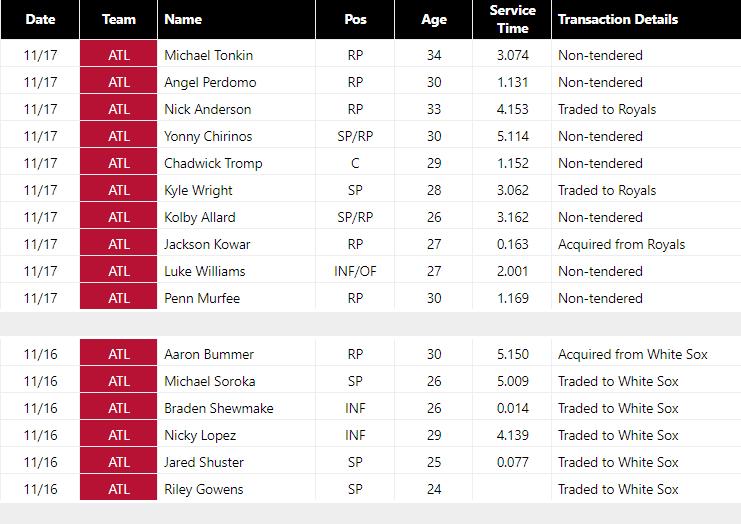
The Braves non-tendered a ton of 40-man occupants on Friday and moved several others in a trade for lefty reliever Aaron Bummer (which I covered in depth here), leaving them with just 31 players on their 40-man roster after they signed Reynaldo López yesterday. They need position player depth, particularly at the middle infield positions. Orlando Arcia is currently the only shortstop on their roster.
It’s incredible that the Braves have one quarter of their roster to play with and also have a very stable, contender-quality depth chart. They have a great player at virtually every position and lots of pitching depth already in place. They have a very spacious roster but only a few specific needs. They’re in position to make a Rule 5 Draft pick if they want to, and in what will likely be the lone bit of Rule 5 speculation you’ll see on this site, I’ll offer that Suwanee native Nasim Nuñez has a skill set congruent with Atlanta’s needs.
At the GM meetings, I asked current Astros GM Dana Brown, who was Atlanta’s Vice President of Scouting for four years, how the pro scouting department in Atlanta was structured compared to the current group in Houston, and he said, “Initially in Atlanta we had more scouts, but then after COVID we lost a bunch, and we went strictly to data, information, evaluation off the screen, and ran it that way.”
Slowly, more and more teams are operating this way, but they’re still in the minority. The Braves have been buyers for so long that it’d be interesting to see them make a decision in the prospect space and perhaps learn more about how they make decisions in the pro scouting realm in general.
Chicago Cubs
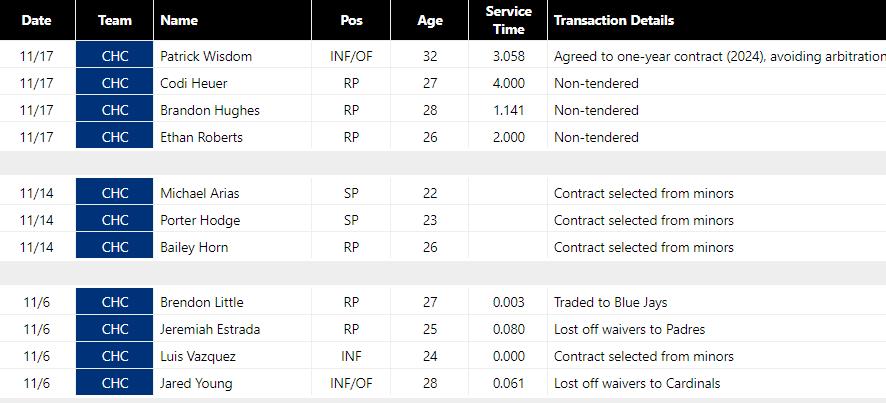
The Cubs lost a few players via waivers (Jared Young and Jeremiah Estrada) and non-tendered some relievers (Codi Heuer, Ethan Roberts, and conversion arm Brandon Hughes) who were backfilled by internal options Michael Arias, Bailey Horn, and Porter Hodge. Arias is himself a converted shortstop with an impact mid-90s fastball featuring uphill angle and carry. He’s a work-in-progress in other facets and may be a reliever in the end, plus he hasn’t yet reached Double-A, but I think it was correct to protect him, as any team could have ‘penned him and made him a fastball-heavy reliever in the short-term. Horn and Hodge are pure relievers. Horn has profiled that way since entering pro ball, while Hodge slid to the bullpen halfway through the 2023 season. What Horn and Hodge provide that Roberts, Hughes and Heuer don’t is health and/or roster flexibility. I consider both to be low-leverage middle relief types.
Cincinnati Reds
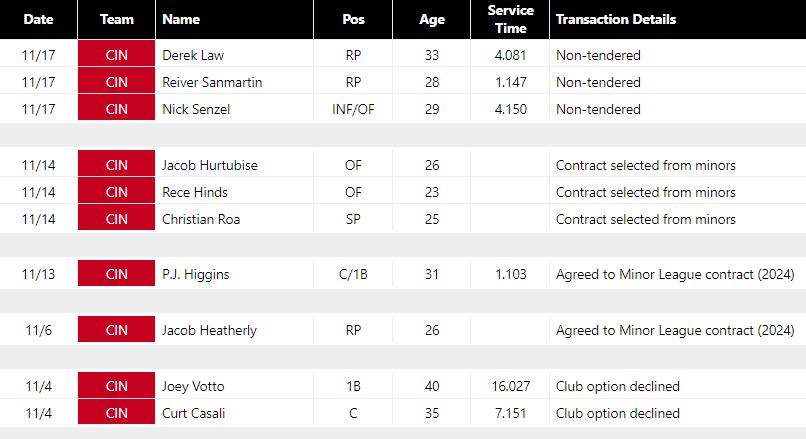
The Reds claimed Bubba Thompson from the Royals at the end of October, then added Jacob Hurtubise and Rece Hinds to their roster from within last week. Additionally, Jose Barrero is getting reps in center field with Estrellas Orientales in the Dominican Winter League. Will Benson‘s 2023 xwOBA was much lower than his real-world production, and Jake Fraley’s foot limited his mobility at the end of the season, so I’d consider this group cloudy but encouragingly deep as we head toward Winter Meetings. It’s likely to be thinned out a bit yet during the offseason (Barrero looks lost at the plate in the D.R.), and yet still be deep and magmatic in February. Hinds has plus-plus power and plus speed, but I’m scared he won’t hit at all. Hurtubise is a lot like TJ Friedl, with a skill set rooted in contact and plus-plus speed. He doesn’t quite have Friedl’s elite soft skills, like baserunning and bunting, however.
Colorado Rockies
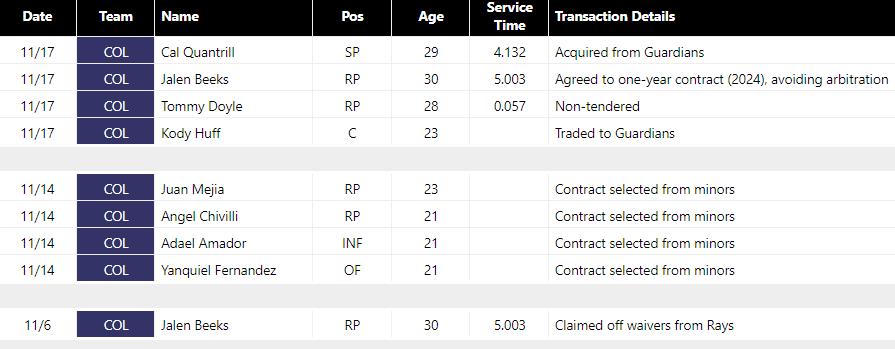
The wave of impact Latin American prospects has begun to swell in Colorado, with Adael Amador, Yanquiel Fernandez, Juan Mejia, and Angel Chivilli added to the roster. Fernandez had a monster start to 2023, but he has a good bit of approach and chase-driven risk as a prospect, and he fell flat on his face after his promotion to Hartford. I think he’ll get to enough power to be a good corner platoon option in spite of his flaws, but I hope readers can see why I was apprehensive about stuffing him on the top 100 during the season. Amador is currently picking up reps in Puerto Rico, where he’s seeing a lot of mid-to-upper-80s fastballs. Because he missed time with injury during the year, it makes sense for him to have played fall/winter ball, but a league with better pitching might have been more appropriate for his development. His statistics against offspeed stuff and breaking balls were not good in 2023 per Synergy, but injuries limited his sample in this regard enough to consider it something to monitor rather than something to be worried about. I still feel like he’s a top 15 or so prospect in baseball as I sit and type this, but I’d have felt better if I had gotten a six- or eight-week look at him against better pitching in the Arizona Fall League, or against veterans in LIDOM.
Mejia and Chivilli are both pure relievers, but both have a chance to be very good ones. Chivilli is only 21 and might get a whole ‘nother year of seasoning in the minors. He sits 94-97 with a plus changeup. I was criminally light on Mejia in my last Rockies write-up. His slider consistency is middling, but some of them are really nasty (including a few in the video below), and his body and mechanical fluidity portend even more velocity as he ages into his mid-to-late 20; I think he could eventually sit 100. Both of these guys could be high-leverage options.
Los Angeles Dodgers

I think both Nick Frasso‘s and Landon Knack’s mechanical consistency and feel for location are a little worse than their low walk numbers might lead one to believe, but they’re both going to rip heaters past big league hitters thanks to their fastballs’ underlying traits. This is especially true of the beanpole Frasso, whose deceptive cross-bodied delivery creates huge extension and funky angle. Knack is a more typical vertical fastball/slider attacker.
Oft-injured with Texas, Ricky Vanasco’s velocity was way down as he returned from TJ and dealt with a knee issue early in 2023. After just a couple of short outings back in affiliated ball, the Rangers designated him for assignment and he was traded to the Dodgers, who shut him down and modified his delivery (throwing exclusively from the stretch, what appears to be a more closed stride direction). By the end of the year, he was working with a pared-down repertoire and touching 98 at Triple-A Oklahoma City. Vanasco became a six-year minor league free agent after the season and the Dodgers signed him to a big league deal. He stands a good chance to play a key role in their bullpen next year as a mid-90s/curveball guy.
Twenty-six-year-old catcher Hunter Feduccia is a well-rounded defender who is especially good at getting on top of high fastballs. He is definitely ahead of Diego Cartaya on the catching depth chart at this very moment, and Feduccia stands a pretty good chance to supplant Austin Barnes as the backup at some point in 2023, especially if Cartaya rebounds and becomes a viable short-term option as the third catcher. Cartaya is still a premium long-term prospect — catcher development is non-linear and I’m not sweating his rough 2023 at all.
This roster still feels rather old and unathletic on the position player side. We don’t truly know whether or not Gavin Lux can play shortstop. Miguel Rojas and Chris Taylor are both old enough for us to wonder how much longer either of them will be passable there. Max Muncy, Michael Busch and Miguel Vargas are below-average defenders, and Jorbit Vivas is landlocked at second base. There have got to be external additions that add middle infield depth and/or defensive versatility here, or the Dodgers will again be vulnerable and shallow at premium positions.
Miami Marlins

Peter Bendix’s first trade in his new President role was to trade for old pals Vidal Bruján and Calvin Faucher, who will hopefully provide role-playing upgrades to a Marlins team presumably still looking to compete for one of the last couple playoff spots in 2024. Bruján has been kept off of Tampa’s big league roster by the depth ahead of him for the last three years; now he’ll get a longer runway to prove he can play a super utility role on a good team. He has experience at every non-1B/C position and has been playing second base and all three outfield positions for Estrellas Orientales in the Dominican this winter. Faucher is a mid-90s/high-spin breaking ball reliever who is coming off of two straight years with an xERA of near 6.00, with the second season coming after Faucher developed a new cutter. He has one option year remaining and I expect it will be used.
To acquire those two, the Marlins sent 17-year-old DSL infielder Erick Lara and righty Andrew Lindsey, a recent draft pick, all the way up Route 75 to Tampa. Lara is a very exciting lefty-hitting infield prospect with a gorgeous swing and fairly projectable frame. He’s an explosive rotator and has natural, power-inducing loft in his cut. The last time the Rays made a seemingly innocuous, long-shot trade for a deep projection DSL bat, it turned out to be pretty consequential for both orgs. Lara hit .305/.416/.445 in the DSL and struck out at a 25% clip, which is high for that league.
Lindsey had a nomadic amateur career that included a year away from baseball before he went to Tennessee. He was throwing very hard early in 2023 (often peaking in the 97-98 mph range), but by the end of the season, he was more frequently living in the 92-94 range with a hard slider. He’s a fair relief prospect.
Victor Mesa Jr. is a good-gloved center fielder (note that my mid-year look was way more favorable than the late-year film study I did for this piece) who hit 18 homers at Double-A in 2023. He’s more of a fourth outfield prospect than a player I’d project to be a regular. I don’t think the power component is for real, as Mesa looks more like a guy who slugs under .400 if given an extended big league opportunity, at least with his current physicality. Anthony Maldonado had a very successful three-year run as a starter at Bethune-Cookman. His pro career began on a bit of a delay because of the pandemic and an injury that cost him a large chunk of 2021. He reached the upper levels of the minors in a relief role very quickly, and he’s been dominant from a bat-missing and strike-throwing standpoint for the last three campaigns, thanks largely to a plus-plus mid-80s slider that has huge vertical finish.
Milwaukee Brewers
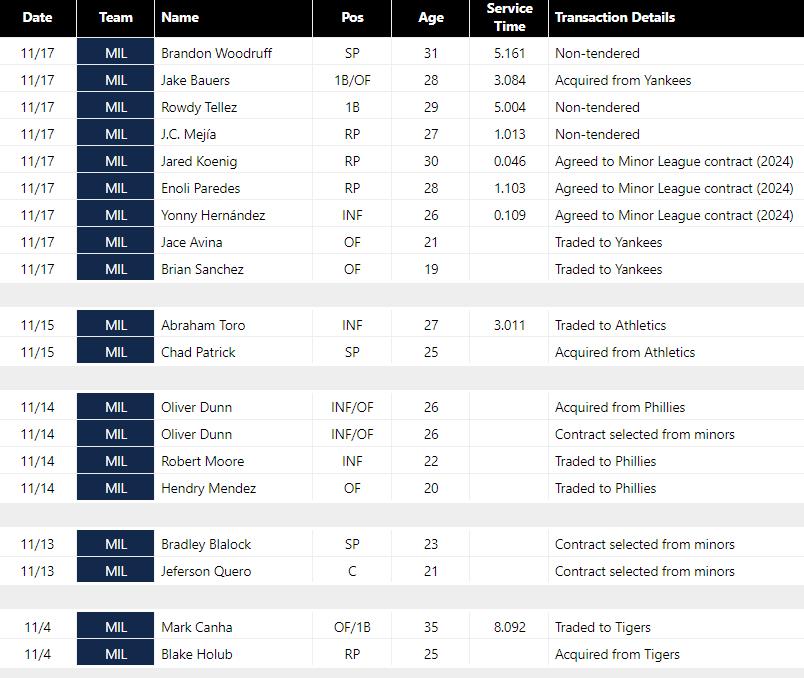
Milwaukee has been very active on the fringe of their roster since late August when they acquired Chris Roller from Cleveland. They also scooped up Vinny Capra on waivers. Most significantly, there are a lot of recent trades to talk through here, so let me get the internal additions out of the way. Jeferson Quero is a lock to be added to the Top 100 prospect list this offseason. His receiving around the edge of the zone has improved considerably, and now his framing (to the eye, anyway) and arm strength are both really excellent. He’s still not a good ball-blocker, but Quero’s other core catching skills are so good for a 21-year-old that I think it’s fine to start projecting him as an impact defender. On offense, his extreme, pull-heavy approach may eventually need some amount of adjustment as big league arms execute sliders away from him, but Quero is pretty clearly an impact all-around prospect now. Bradley Blalock (acquired from Boston at the deadline) has a modern starter’s mix with a vertically-oriented fastball and two good breaking balls that pair well with the heater and with one another. He returned from TJ in 2023 and may still be on a conservative innings count in 2024, but I expect he’ll establish himself as a rotation piece by 2025.
Now on to the trades. Michael Baumann covered the Mark Canha trade here, while I wrote about Milwaukee’s trade for Oliver Dunn here. The Brewers traded a Meg Rowley favorite, Abraham Toro, to Oakland for righty Chad Patrick, who the A’s got from Arizona at the deadline for Jace Peterson. Patrick sits 91-94 and has remarkably consistent feel for a low-80s slider/cutter. His stuff is light enough that I have more of a spot starter grade on him than I do future rotation projection. He doesn’t have to be on the 40-man for another year.
Milwaukee also acquired Jake Bauers from the Yankees for two outfield prospects. One is Jace Avina, a now-20-year-old former Nevada high school draftee with impressive power for a hitter his size (5-foot-11, 180 pounds) but pretty significant issues swinging underneath high fastballs. Brian Sanchez presents a well-rounded look on paper as his control of the zone, bat-to-ball feel, and barrel rate all look pretty good. He’s a longer-bodied, projectable teenager and might grow into more power. He’ll probably need to because he’s a below-average runner, athlete, and defender who might need to move to first base. Bauers’ 2023 contact quality was better than his observed results, but he hasn’t been an above-replacement player since 2018.
New York Mets
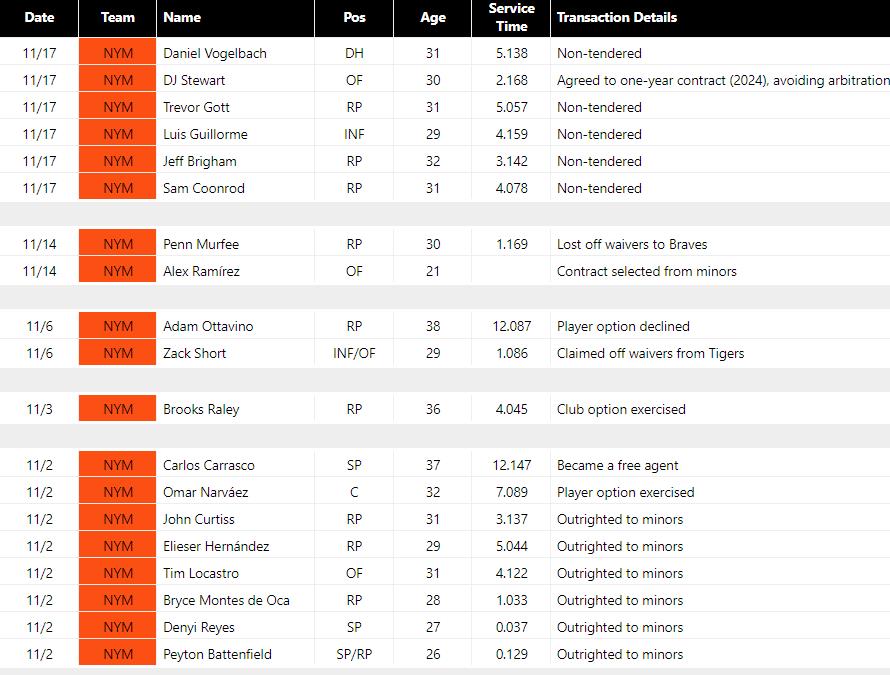
Not a ton happened here in terms of the 40-man deadline, though there were a bunch on non-tenders last week. I’d guess that toolsy, free-swinging outfield prospect Alex Ramírez will spend his whole first year on the 40-man trying to develop better plate discipline in the upper minors; he might well spend the better part of the next two seasons doing that. The Mets only have 28 players on their 40-man as I’m writing this, and clearly need pitching (both depth and a high-end guy or two).
Philadelphia Phillies
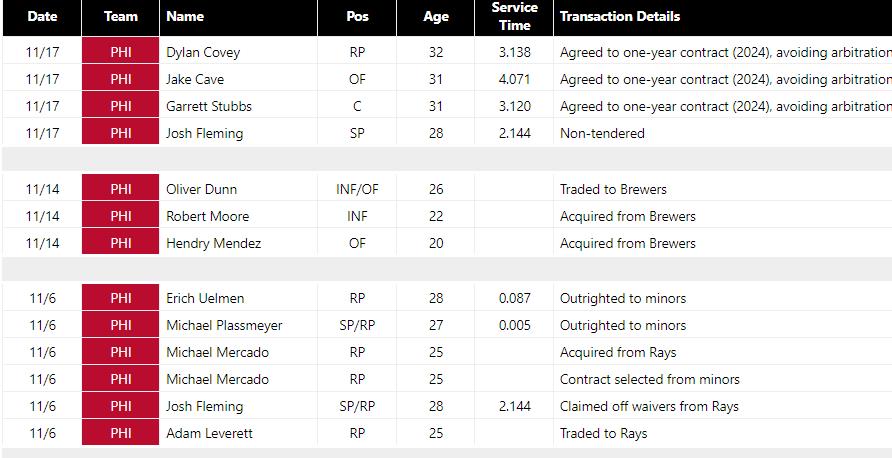
I wrote about the trade of Oliver Dunn for Hendry Mendez and Robert Moore here. A week prior, the Phillies acquired Michael Mercado from the Rays for Double-A swingman Adam Leverett. Mercado throws hard (93-96, touched 98 late in the year with Durham) and more recently began incorporating a cutter, which has become his best secondary pitch, into his repertoire. The angle of his fastball makes it more hittable than the velocity might lead you to believe. This trade continued the Phillies’ Dombrowski-era trend of acquiring hard-throwing relievers with fastballs that play down a bit. Perhaps we can consider Mick Abel to be upper-level rotation depth at this point even though he hasn’t had to be put on the 40-man yet, but the Phils still need to find a couple more guys to buttress their talented big league rotation. Their bullpen and lineup are both stacked, and Philly’s reserve group (Garrett Stubbs, Cristian Pache, Edmundo Sosa, whichever of Brandon Marsh and Johan Rojas doesn’t start) is much more settled and explicitly useful than most other contenders can tout right now.
Pittsburgh Pirates
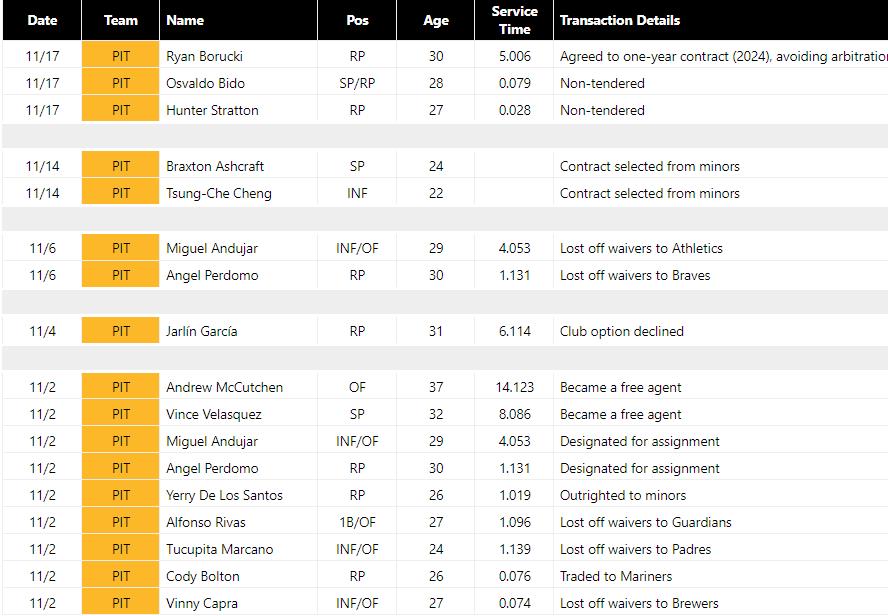
The Pirates’ time could be nigh. They still need a mashing corner outfield upgrade to the incumbent Connor Joe/Joshua Palacios platoon (it might ultimately be Oneil Cruz, depending on how mobile he is returning from injury), but otherwise the players currently on their roster are young guys who have mostly been evaluated pretty strongly here at FanGraphs, and now it’s time for them to sink or swim at the big league level as a group. Adding Braxton Ashcraft (sitting 95-97 with two decent breaking balls late in the year) adds to what was already a ton of homegrown depth and flexibility on their pitching staff, and that’s before considering that Paul Skenes, Thomas Harrington, Jared Jones and other non-40 man occupants could be swiftly on their way. I think Pittsburgh is going to be in the thick of a very entertaining four- or five-team NL Central race next year, but whether they become actual contenders across the next two or three years will depend on how many of these youngsters become high-end impact players like the Braves and Phillies have up and down their lineups.
Light-hitting Taiwanese infielder Tsung-Che Cheng has plus feel for contact and can play shortstop, but at 5-foot-7, his offensive forecast is limited by a lack of physicality. He is probably a utilityman in the long run and currently behind Alika Williams and Nick Gonzales on the depth chart.
San Diego Padres

The Padres rotation still needs proven help from outside the org. Jairo Iriarte is a potentially significant long-term part of San Diego’s staff but may be too crude to be a 2024 contributor. The ultra-loose 21-year-old righty has a nasty rise-and-run fastball and plus slider, but his velo was down a little bit late in the year and he’s still rather wild. He’s going to be a Top 100 prospect this offseason by virtue of his stuff, bodily fluidity, physical projection, and relative proximity to the big leagues, and if/when things click for him, he’s going to be a key part of San Diego’s rotation. It’d be ideal for San Diego to have proven starters ahead of him on the depth chart when camp starts in case it takes a while for that to happen.
The Enyel De Los Santos for Scott Barlow trade was a slight downgrade for the Padres in terms of stuff/talent, but De Los Santos is under team control for another three seasons while Barlow is a free agent after 2024.
Oft-injured Palm Desert native Jeremiah Estrada was claimed off waivers from the Cubs. He’s a fastball-heavy mid-90s reliever whose changeup has regressed since his early prospect days. With just 31 players on their 40-man roster right now, the Padres have the space to address their bench. The NRI additions of Robert Perez Jr. (plus power) and Cal Mitchell (lovely swing) are a couple of early offseason dart throws. San Diego’s penchant for pushing prospects quickly puts Jackson Merrill and Graham Pauley in their mid-season DH/1B mix from my point of view, especially if Jake Cronenworth keeps struggling.
San Francisco Giants

Trevor McDonald was dominant in 2023 after returning from AC joint and hamstring issues. For those of you obsessed with release height, this is your guy. McDonald has an extreme drop-and-drive delivery with an open stride. It is not sexy to look at, but it does create a really tough line on his fastball, and McDonald has shown an ability to manipulate fastball shape and create bat-missing action on his slider and changeup from this slot. He’s a good long-term prospect who will hopefully stay healthy and sustain his stuff across a full season workload in 2024. I was a little surprised the Giants added the walk-prone duo of Kai-Wei Teng and Erik Miller to their roster. Teng (13% walk rate each of the past three years) has a plus slider and Miller (over seven walks per 9 IP in 2023) is capable of missing bats with three pitches, but I’d have bet both would be too wild in a spring training audition to stick on their new roster.
At the GM Meetings, I asked Farhan Zaidi his thoughts on whether the Giants’ platoon-heavy approach to lineup building limited their ceiling, considering that most of the World Series teams from the past few years (like the Phillies, Rangers, Astros, Dodgers, Braves, and even the D-backs) have mostly had plug-and-play, omni-situational position players up and down their lineups. I don’t have an anti-platoon predisposition, quite the opposite, which is part of why I’ve been reflecting on it lately. Zaidi pushed back on the premise a bit and told me, “I would counter that a little and say you see teams playing match-ups more in the playoffs than you do during the regular season. You see guys being pinch-hit for, in my opinion, in situations where they wouldn’t be hit for during the regular season. I know there was that game in the ALCS where the Rangers started Robbie Grossman instead of Evan Carter, then put Carter in the game once Framber Valdez was out. I still think you see a lot of those match-ups. I think everybody in baseball would rather have an everyday guy than a platoon player. It’s stabilizing, you get a more consistent defensive look to your team. Usually when you have a platoon set-up, it’s to try to achieve a level of production that you wouldn’t get if you just ran one of those players out there all the time.”
St. Louis Cardinals

The Cardinals have had turnover at their third catcher spot (Andrew Knizner out, glove-oriented backup Pedro Pagés in), among their corner bat reserves (Juan Yepez out, Buddy Kennedy and Jared Young in) and, as is typical across baseball, with the bottom of their pitching staff. You can find scouting reports on Sem Robberse and Adam Kloffenstein from my write up of the Jordan Montgomery and Jordan Hicks deals, which includes my thoughts on St. Louis’ goal of a quick franchise rebound, here. Twenty-eight-year-old righty Riley O’Brien was acquired from Seattle for cash. The former starter had a velo spike when he moved to the bullpen, and he now has a mid-90s sinker and plus curveball.
Washington Nationals
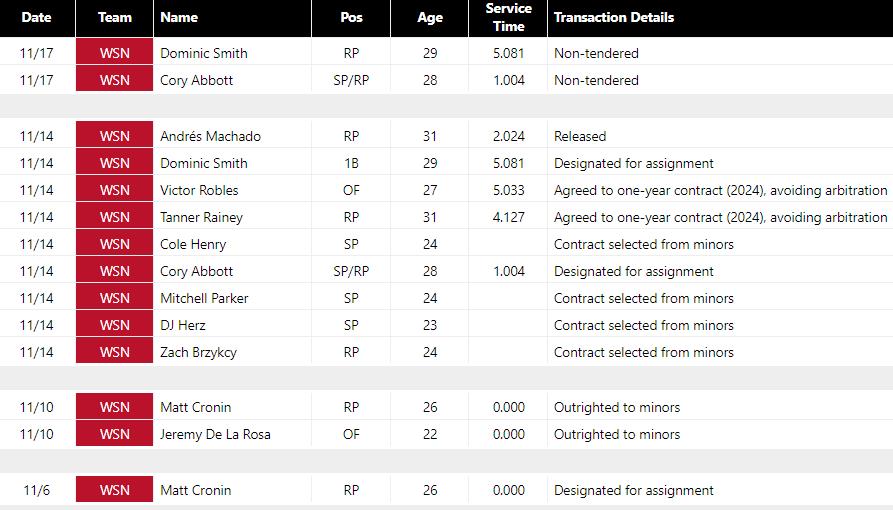
Washington added several exciting young relievers to their roster. The workload of oft-injured Cole Henry tapered off late during the season and his last several outings came in relief. I think it’s fair to project him as a pure reliever going forward. Zach Brzykcy (pronounced “brick-see”) was a power reliever at Virginia Tech and became one of the first 2020 undrafted free agents to emerge as a real prospect. He quickly went from sitting 94-95 mph out of the Hokies bullpen in his first 2020 appearance to sitting 96-98 and touching 99 in his last few just before the COVID shutdown. He didn’t pitch in 2023 because he was recovering from Tommy John. Mitchell Parker is a vertical slot lefty with a great curveball and below-average control. DJ Herz is a cross-firing lefty with below-average velocity and a plus changeup.
Source
https://blogs.fangraphs.com/40-man-roster-deadline-reaction-and-analysis-national-league/
 Backyard GrillingWeekend WarriorsAdvice from DadBeard GroomingTV Shows for Guys4x4 Off-Road CarsMens FashionSports NewsAncient Archeology World NewsPrivacy PolicyTerms And Conditions
Backyard GrillingWeekend WarriorsAdvice from DadBeard GroomingTV Shows for Guys4x4 Off-Road CarsMens FashionSports NewsAncient Archeology World NewsPrivacy PolicyTerms And Conditions
